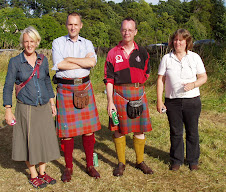I knit with passion yesterday to reach the neck shaping and form what EZ calls a kangaroo pouch with my steek. Then I had to do another ¾” before I was allowed to start the shoulder pattern. It’s childishly simple, and a steek seems rather an over-elaborate means to avoid purling it. Still, two colours are two colours, and purling them is hell.

At 2” I am to abandon some more stitches, and make another steek, in the back. I hope soon there will be enough pattern that you can actually see it in a picture.
Theresa, don’t go away. (Comment yesterday – she’s knitting the Slicer-Smith Harlequin coat.) I spent some more time with the book yesterday. I had already grasped what you say, that first you knit the skirt top down and then turn it over and knit bottom up. Yesterday I solved one of my remaining problems – how do you achieve different sizes in the skirt? I could see already how the bodice is shaped, and it’s rather ingenious.
Today’s question is, where are the armholes?
I wonder if there’s a Ravelry group?
It occurred to me yesterday that this coat/jacket, in which mitered squares are combined into a shaped garment, may be a break-through of Slicer-Smith’s own. Herr Schulz and Maie Landra have wonderful colours and wonderful squares and wonderful combinations – see especially Landra’s legendary Oriental Jacket – but little or nothing in the way of shaping. Another book on mitred knitting recently swam into and out of my ken. It was by someone we have heard of. Does anyone know what I could be thinking of? And whether garments are shaped in that one?
And, Theresa, there’s a whole book on Knitting Brioche, not yet published here in Britain. Needless to say, I have ordered it. I spent some time rearranging knitting books the other day. I am seriously running out of space.
Non-knit
Neil MacGregor’s programme this morning – the one I listened to, anyway; I’m a couple of days behind – had another remarkable simultaneity for me: about 50,000 years ago, people all over the world started decorating things, and making images. Today’s object was about 13,000 years old – a mere nothing, time-wise. It was a mammoth’s tusk, carved into an image of reindeer swimming, and apparently useless, fully qualifying as art. The Ice Age was in full swing 13,000 years ago, he said. Its end, an early example of Global Warming, may have had something to do with the simultaneous world-wide rise of great cities.
Helen, (comment yesterday), “King of England” – or, as appropriate, “Queen” – is an American expression meaning, roughly, someone impossibly grand or someone who thinks himself so. Can any American reader confirm that the phrase is still in use, or was it just something my mother used to say?



Jean, I can't remember the last time I used "King/Queen of England" as you describe, above, but I'm fairly sure the phrase would be understood as intended. It would not come across as old-fashioned to me (I am, let's say, "early middle aged"). I do wonder if some of the phrase's effectiveness has diminished from years ago, given that some of the shine has worn off of the royals.
ReplyDeleteMaybe I'll try it on my (college) students, or ask them about it.
My mom occasionally uses the phrase "king" or "queen"- but of Spain!!! LOL- maybe its because we are Mexican American, (and especially since my father's family is indigenous- it is meant to be rather derogatory) but yeah, that is the way I heard it while growing up!
ReplyDeleteAnd in our house, via my Irish grandmother, the phrase was 'his honor the mayor' -
ReplyDeleteThanks for the book link. Like you I have to be careful as I am running out of space. I try to check the library before investing but they do not always have the most current books.
ReplyDeleteI will have to say that as much as I love Jane Slicer-Smith and her designs that the book is difficult to follow in places and there are a few mistakes,not unusual in the first printing of a book.
I don't remember about the Harlequin coat armholes exactly but will look at it again tonight.
She often doesn't use shoulder seams and designs the shoulders to be narrow to accommodate the give on the shoulder.
do you mean Vivian Hoxbro 's book on mitred squares? I cannot remember clothing in it, just shawls, afghans, pillow covers and bags (the book is with a friend so i cannot check).
ReplyDeleteIf it's Vivian Hoxbro's "Domino Knitting" of which you are thinking, I just perused my copy of the book. It's a small book, and there are patterns, but only for potholders, a purse, some hats, and some rectangular shawls. No shaping is done on any of the items.
ReplyDeleteYes, in the USA we still use the term "Queen of England," as in "Who does she think she is, the Queen of England?"
Mary G. in Texas
"Who do you think you are, the Queen of Sheba?"-- and yes, it does sound old-fashioned and did even when my parents used it, as they were deliberately quoting a funny old line from their grandparents' era (or, who knows, even earlier).
ReplyDelete-- Gretchen
Queen of Sheba is the one ringing bells for me (UK, mid 40s if that helps!)
ReplyDeleteAnd hasn't Vivian Hoxbro written more than 1 mitred book?
Ginger Luters' Module Magic book has shaped garments, though not all are made with mitered squares...
ReplyDelete